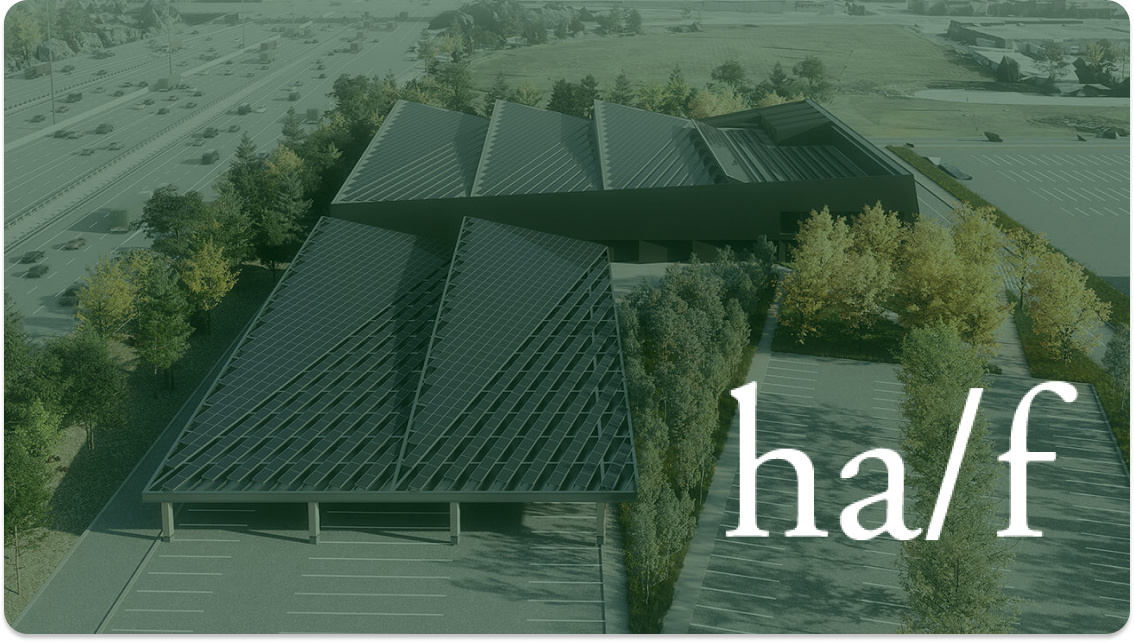
Ha/f Climate Design successfully reduced 800 tons of carbon on the City of Toronto’s Paramedic Services Multifunction Station — without additional time or cost to the project.
“The power of One Click LCA is the database sitting behind it. You have access to more data, which leads to better decisions.”
– Kelly Alvarez Doran, co-founder of Ha/f Climate Design
Ha/f is a research and design consultancy, founded by Kelly Alvarez Doran and Juliette Cook in 2022, which aims to halve greenhouse gas emissions from buildings this decade. Based in Toronto, Canada and London, United Kingdom, Ha/f works with architects, city planners, and policymakers to develop climate solutions for the built environment. In addition to offering whole-building life-cycle assessments (LCA) and circular economy services to clients, Ha/f is dedicated to sharing knowledge on embodied carbon and boosting LCA literacy among industry professionals through various educational initiatives, including talks, workshops, and presentations.
On a mission to raise awareness on whole life carbon best practices, Ha/f uses One Click LCA in various scenarios:
- Training architects on how to incorporate LCAs into their projects
- Lecturing about sustainable design practices at institutions, such as the University of Toronto and the University of Waterloo
- Showing governmental entities how specific policies can influence carbon emissions
- Providing recommendations to clients on reducing embodied carbon for building projects
A forward-thinking project with the City of Toronto: Toronto Paramedic Services Multifunction Paramedic Station
Net zero carbon and net zero energy were the targets for the new City of Toronto Paramedic Services Multifunction Paramedic Station, designed by architects Diamond Schmitt and gh3* with LCA analysis conducted by Ha/f.
Located along a highway in the Scarborough district of Toronto, the sleek angular building, which received the 2021 Canadian Architect Award of Merit, consists of an emergency vehicle bay connected to an administration and educational area. It is complete with a distinct tilted sawtooth roof that optimizes solar energy use and generation. The anticipated completion date of the building is 2024.
Ha/f performs an LCA during a later stage of design to further reduce embodied carbon
As part of a broader embodied carbon benchmarking study for the City of Toronto, backed by The Atmospheric Fund, Ha/f conducted a detailed 60-year LCA of the Toronto Paramedic Services Multifunction Paramedic Station using One Click LCA.
Since Ha/f entered the project during a later design phase, the team reviewed the project’s construction documents and identified the primary opportunities for reducing carbon emissions as specification swaps in favor of lower-carbon alternatives.
Using One Click LCA led to 800 tons of additional carbon reduction at no extra time or budget cost
“For this project, we were brought in after the design development stage, so there was already a level of specification in terms of the materials being used. It was helpful to have software that met that level of definition. At the time of the assessment, other tools can be more limited in terms of system boundaries and data available.”
– Juliette Cook, co-founder of Ha/f Climate Design
To evaluate the building's environmental performance, Ha/f input the gathered material quantities into One Click LCA to conduct an LCA. The team found the software's visualizations and the vast collection of LCA datapoints helpful for uncovering ways to improve the building's environmental impact. The tree graph identified carbon hotspots, which included extruded polystyrene insulation (XPS) and sub-slab conditions, lower-carbon concrete, concrete masonry units (CMU), structural steel, paints, and coatings. Meanwhile, the waterfall graph zoomed into the potential embodied carbon reduction of specification swaps.
After conducting material research, Ha/f suggested a series of lower-carbon options to the architects that wouldn’t change the dimensions of the project but could reduce roughly 30% of the carbon on the project:

- Lower impact XPS insulation and recycled glass gravel insulation
- Lower carbon concrete (Portland-Limestone cement + high percentage of supplementary cementitious materials) in targeted locations
- Hempcrete block with lime mortar instead of CMU
- Structural steel with a higher recycled content
- Lower impact concrete slab sealant for the paint and coatings in the buildings
Conclusion
For the City of Toronto Paramedic Services Multifunction Paramedic Station, Ha/f used One Click LCA at a later stage of the design process to gain a deeper understanding of the building's environmental impact and to unearth opportunities to further reduce embodied carbon for the project. Harnessing the LCA data offered in the software, the team developed recommendations that led to 800 tons of avoided carbon emissions at no additional cost to the project's budget or timeline.
Ha/f uses One Click LCA's tools in its advocacy and educational work to spur the adoption of whole-building LCA and sustainable design practices in the industry.
Carbon Experts Newsletter
Industry news & insights — straight to your inbox
Want to learn more?
Muhammad Ali Saleem • Mar 15 2025
Aileen Carroll • Feb 07 2025
Aileen Carroll • Mar 20 2025
Muhammad Ali Saleem • May 29 2025
